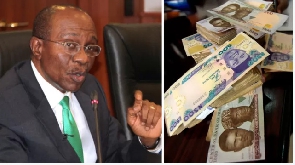Central Bank of Nigeria don announce say dem go redesign all di major naira notes for di kontri. Di major naira notes wey CBN tok say dem go redesign na ₦100, ₦200, ₦500,and ₦1000. CBN Govnor Godwin Emefiele say di reason why dem dey change di notes na sake of request from federal goment. Tori be say di last time di bank do dis kain tin to di naira na for 2014. Dat year dem change di design of ₦100, to celebrate Nigeria centenary. President Muhammadu Buhari don approve di redesign, production, and circulation of di new series of banknotes. Wetin go happun to old naira notes wen CBN launch new designs? According to di govnor, CBN don finalise arrangements for di new currency to begin circulation from 15 December, 2022. Emefiele say di new and old currencies go still dey valid and dem go dey in circulation together until January 31, 2023. But afta dat date you no go fit use di old money again. All commercial banks wey currently get dis denominations of currency fit begin return di notes back to CBN wit immediate effect. “We go release di new design of di currency dem to bank based on first-come-first- serve basis,” e tok. “E advise bank customers to begin pay di old currency into dia bank accounts. According to am e go enable dem withdraw di new banknotes once di money dey in circulation for mid-December 2022. All banks dey expected to keep their currency processing centers open from Monday to Saturday. Dis go accommodate all di cash wey customers go return.” Based on di transition from old notes to new ones CBN don suspend bank charges for cash deposits. But dem say deposits above ₦150,000 go still attract charges. History of Nigeria currency - 1880: Nigeria first major currency na Shillings and Pence. Di units of coins wey Bank of England bin dey manage na one shilling, one penny, 1/2 penny, 1/10 penny and na private bank bin dey distribute am, dat na di Bank for British West Africa until 1912. - 1912 -1959: West African Currency Board (WACB) issue di first set of banknotes and coins for Nigeria, Ghana, Sierra Leone and Gambia. Di highest banknote denomination dat time na one pound, while one shilling coin na di highest coin denomination. - 1959: Central Bank of Nigeria (CBN) issue Nigerian currency banknotes, as we withdraw from di WACB- banknotes and coins - 1962: But na dis year di change reflect di kontri republican status. Di banknotes wey carry di write up, ’FEDERATION OF NIGERIA‘, change to ‘FEDERAL REPUBLIC OF NIGERIA’, for di top. - 1968: Di notes change again sake of di misuse of di currency during di civil war. - 1973: Di name of Nigerian currency change. £1 di major unit of currency wey we bin dey use to cease to exist. One naira bin dey equivalent to ten shillings, become di major unit, while di minor unit wey dem call kobo; hundred of which make one naira. - 1977: Dem introduce anoda new banknote, di twenty naira (₦20). Na di highest denomination dem introduce at dat time sake of economy growth of the economy and convenience. For di first time dem use photo of popular Nigeria citizen for di bank note. - 1979: Dem introduce new currency banknotes of three denominations, ₦1, ₦5 and ₦10. In order to identify di money easily, dem use different colours for all di denominations. For di back of di notes di drawings reflect various cultural aspects of di kontri. 1984: Dem change all di colours of di bank notes for circulation except di 50 Kobo banknote to arrest di currency trafficking palava at dat time. 1991: Di 50K and ₦1 dem change dem to coins. 1999: In response to di expansion in economic activities and to facilitate efficient payments system, dem introduce di ₦100, ₦200, ₦500 and ₦1000 banknotes were introduced for December 1999, November 2000, April 2001 and October 2005 respectively. 2007: As part of di economic reforms, dem release ₦20 for di first time in polymer substrate. While dem change di designs of ₦50, ₦10 and ₦5 banknotes; as well as ₦1 and 50K, and dem introduce ₦2 coin. 2009: Dem redesign ₦50, ₦10 and ₦5 banknotes and convert am to polymer substrate sake of di successful performance of di ₦20 (polymer) banknote. Now, all lower denomination banknotes dey in polymer substrate. 2010 and 2014: CBN, issue new ₦50 and N100 to celebrate di nation 50th anniversary of Nigeria Independence and 100 years of its existence as a nation.
BBC Pidgin of Friday, 28 October 2022
Source: BBC




















